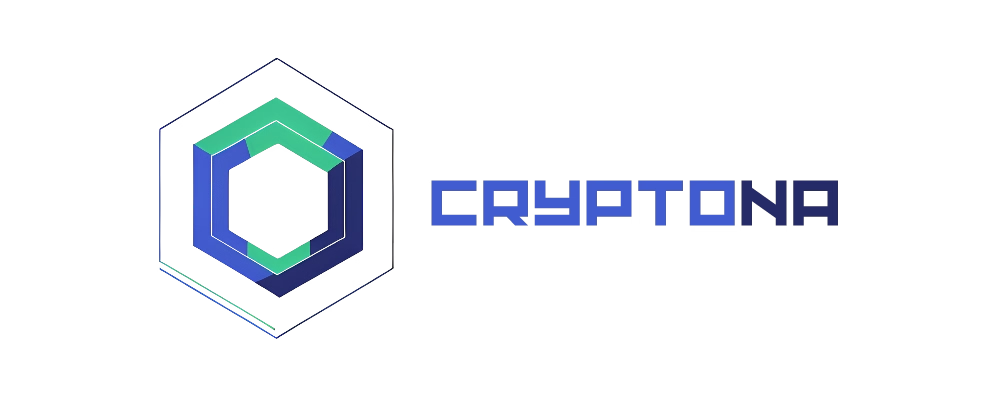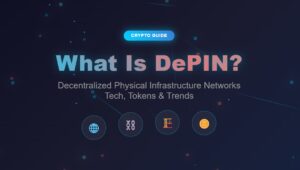The cryptocurrency ecosystem is constantly evolving, and one of the most exciting narratives gaining momentum in 2025 is DePIN—Decentralized Physical Infrastructure Networks. This innovative concept represents a fundamental shift in how we think about infrastructure development, bridging the gap between blockchain technology and real-world applications.
What Is DePIN in Crypto?
DePIN refers to Decentralized Physical Infrastructure Networks, where blockchain and token rewards are used to build infrastructure in the physical world. In simple terms, DePINs use blockchains and tokens to incentivize people to collectively build and share physical services or resources.
DePIN (Decentralized Physical Infrastructure Network) is an innovative concept that integrates blockchain technology with physical infrastructure. By leveraging incentive mechanisms, DePIN combines distributed physical resources such as IoT devices, network nodes, and storage facilities to create a decentralized, collaborative infrastructure network.
Think of it this way: instead of relying on large corporations to build and maintain infrastructure like cell towers, data centers, or WiFi networks, DePIN enables individuals to contribute their own resources and get rewarded with cryptocurrency tokens for their participation.
How Decentralized Physical Infrastructure Networks Work
Decentralized physical infrastructure networks (DePINs) are a decentralised network architecture using blockchain technology. Physical Resource Networks are used to collectively operate physical infrastructure like wireless networks, energy grids, and transportation systems, while Digital Resource Networks manage digital resources such as bandwidth and computing power. Participants can earn rewards by contributing data or services to the network.
The DePIN model operates on a simple but powerful principle: replace bloated infrastructure with crypto incentives and a network of independent operators. Instead of centralized telecom giants, you’ve got individuals running devices from garages, rooftops, and back offices. Cell towers become community-powered. Sensor grids are crowdsourced. Cloud storage is distributed across thousands of independently operated machines.
Key Components of DePIN Networks
| Component | Description |
|---|---|
| Physical Infrastructure | Hardware devices like wireless hotspots, sensors, storage devices, or computing nodes |
| Blockchain Protocol | The underlying technology that records contributions and manages rewards |
| Token Economy | Cryptocurrency tokens that incentive participation and facilitate network governance |
| Community Governance | Decentralized decision-making processes for network development |
The Technology Behind DePIN
DePINs are the bridge between the physical and digital worlds. They use blockchains and provide token rewards for publicly recorded services. The technology stack typically includes:
Blockchain Infrastructure
DePIN projects leverage various blockchain networks to record contributions, manage token distribution, and ensure transparency. Smart contracts automate the reward mechanisms, ensuring participants receive tokens based on their actual contributions to the network.
IoT Integration
Many DePIN projects incorporate Internet of Things (IoT) devices to collect data, provide services, or contribute to the network infrastructure. These devices can range from simple sensors to sophisticated computing nodes.
Cryptographic Proof Systems
To verify that participants are genuinely providing the claimed services, DePIN networks often implement proof mechanisms such as Proof of Coverage (for wireless networks) or Proof of Storage (for data storage networks).
Current DePIN Market Trends in 2025
As of February 2025, the DePIN ecosystem has experienced significant growth, now comprising over 1,170 active projects across various sectors. The most apparent narrative that marks the crypto theme in 2024 and the current market cycle is the integration of Web3 with the physical world. The explosive growth of Tokenized Real-World Assets (RWAs) and the burgeoning innovation of Decentralized Physical Infrastructure Networks (DePIN) exemplify this trend.
AI and IoT Convergence
AI and IoT are two of the most transformative tech trends of the decade and both depend heavily on real-time, reliable, and decentralised data pipelines. AI agents need large amounts of compute power, distributed memory, and access to up-to-date, verifiable external data. IoT networks generate massive amounts of sensor data, which must be stored, validated, and made accessible without relying on central servers. DePIN provides the physical substrate for this convergence.
Types of DePIN Projects
DePIN networks can be broadly categorized into several types based on their primary function:
| Network Type | Description | Examples |
|---|---|---|
| Wireless Networks | Decentralized wireless infrastructure where individuals deploy hotspots and provide connectivity while earning tokens | Community-powered cell towers, WiFi networks |
| Data Storage Networks | Decentralized storage solutions where participants contribute storage space and bandwidth in exchange for cryptocurrency rewards | Distributed cloud storage, file sharing networks |
| Computing Networks | Distributed computing platforms that allow users to contribute processing power for various computational tasks | GPU sharing, distributed processing |
| Energy Networks | Decentralized energy grids that enable peer-to-peer energy trading and grid management through blockchain technology | Solar panel networks, battery storage systems |
| Transportation Networks | Mobility solutions that leverage blockchain to create decentralized ride-sharing, logistics, or transportation infrastructure | Peer-to-peer ride sharing, delivery networks |
| Sensor Networks | Environmental monitoring and data collection networks that reward participants for deploying and maintaining sensor devices | Weather stations, air quality monitors |
Major DePIN Tokens and Projects
The DePIN space features numerous innovative projects, each targeting different aspects of physical infrastructure:
Wireless Infrastructure
Several projects focus on building decentralized wireless networks, offering alternatives to traditional telecom infrastructure. These networks typically reward users for deploying and maintaining wireless hotspots.
Storage Solutions
Decentralized storage networks allow individuals to monetize unused storage space while providing distributed data storage solutions that are more resilient than centralized alternatives.
Computing Power
Distributed computing networks enable users to contribute idle computational resources and earn tokens while supporting various computing-intensive applications.
Benefits of DePIN Networks
| Benefit | Description |
|---|---|
| Cost Efficiency | By leveraging existing resources and community participation, DePIN networks can build infrastructure at a fraction of the cost of traditional centralized approaches |
| Increased Accessibility | DePIN democratizes infrastructure development, allowing anyone with the necessary hardware to participate and earn rewards |
| Enhanced Resilience | Distributed infrastructure is inherently more resilient to failures, attacks, or natural disasters compared to centralized systems |
| Community Ownership | Participants have a stake in the network’s success, creating aligned incentives for long-term sustainability and growth |
| Global Reach | DePIN networks can expand into underserved areas where traditional infrastructure providers find it economically unfeasible to operate |
Challenges and Considerations
| Challenge | Description |
|---|---|
| Technical Complexity | Managing distributed physical infrastructure presents unique technical challenges, including ensuring service quality, handling device failures, and maintaining network security |
| Regulatory Uncertainty | The intersection of cryptocurrency, physical infrastructure, and various regulatory jurisdictions creates complex compliance challenges |
| Token Economics | Designing sustainable token economies that balance participant rewards with long-term network viability requires careful consideration |
| Hardware Requirements | Many DePIN projects require participants to purchase and maintain specialized hardware, which can be a barrier to entry |
| Quality Control | Ensuring consistent service quality across a distributed network of independent operators can be challenging |
The Future of DePIN in Crypto
DePIN (Decentralized Physical Infrastructure Networks) projects are connecting blockchain technology with real-world infrastructure in interesting ways. These networks let people use crypto tokens to build and manage physical systems – everything from wifi hotspots to solar panels. By decentralizing ownership and governance, DePIN enables more transparent, efficient, and resilient systems, aligning with the core principles of Web3.
Emerging Opportunities
The DePIN sector is poised for continued growth as several factors converge:
- Increasing IoT Adoption: The proliferation of connected devices creates more opportunities for decentralized infrastructure networks.
- 5G and Edge Computing: The demand for distributed computing and connectivity infrastructure aligns perfectly with DePIN capabilities.
- Sustainability Focus: DePIN networks can contribute to more sustainable infrastructure development through efficient resource utilization.
- Web3 Integration: As the broader Web3 ecosystem matures, DePIN provides crucial real-world utility and adoption drivers.
Investment Considerations
When evaluating DePIN projects for investment, consider:
- Real-world utility and demand for the infrastructure being built
- Token economics and sustainability of the reward mechanism
- Technical feasibility and the team’s execution capability
- Regulatory compliance in target markets
- Community adoption and network effects
Getting Started with DePIN
For those interested in participating in DePIN networks:
As a Contributor
- Research active DePIN projects in your area of interest
- Understand hardware requirements and initial investment needs
- Evaluate potential returns and associated risks
- Consider technical support and community resources available
As an Investor
- Analyze the project’s whitepaper and tokenomics
- Assess the team’s track record and technical capabilities
- Evaluate market demand for the proposed infrastructure
- Monitor community growth and adoption metrics
Conclusion
DePIN represents a paradigm shift in infrastructure development, leveraging blockchain technology and cryptocurrency incentives to create more efficient, resilient, and democratized physical networks. Decentralized physical infrastructure networks, DePIN for short, seem like it could be the natural evolution of blockchain technology beyond the realm of Web3 and into the real world.
As the sector continues to mature in 2025 and beyond, DePIN projects are likely to play an increasingly important role in bridging the gap between digital assets and real-world utility. Whether you’re interested in contributing to these networks or investing in DePIN tokens, understanding this emerging sector is crucial for anyone following the evolution of cryptocurrency and blockchain technology.
The convergence of AI, IoT, and blockchain technology creates unprecedented opportunities for decentralized infrastructure development. As more projects launch and mature, DePIN could fundamentally reshape how we think about infrastructure ownership, development, and maintenance in the digital age.
Remember to conduct thorough research and consider your risk tolerance before participating in any DePIN project or investing in related tokens. The cryptocurrency market is highly volatile, and DePIN projects face unique technical and regulatory challenges.






















Leave a Reply